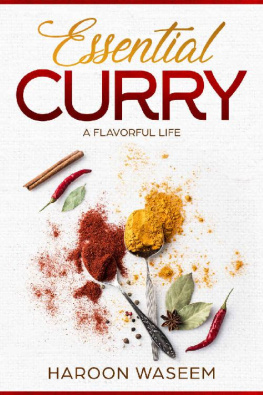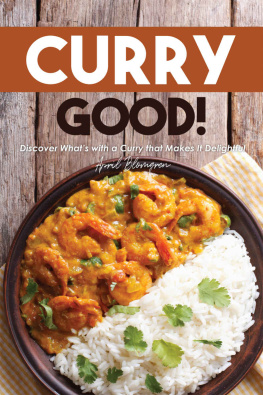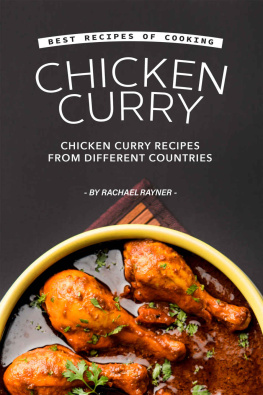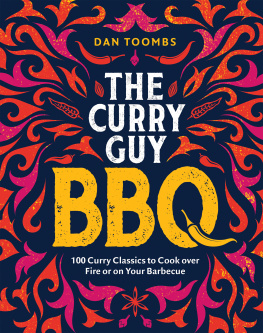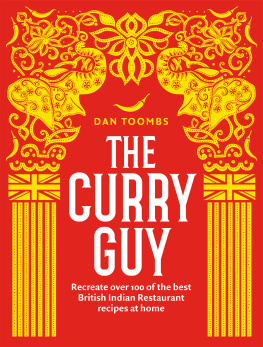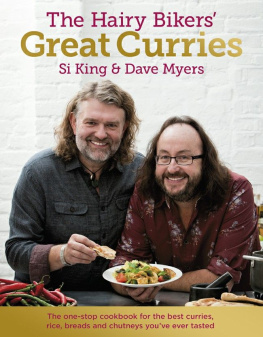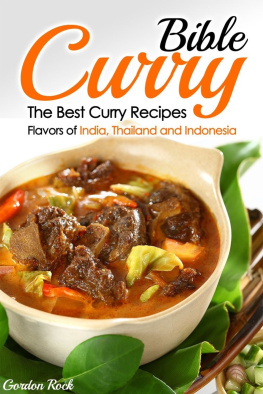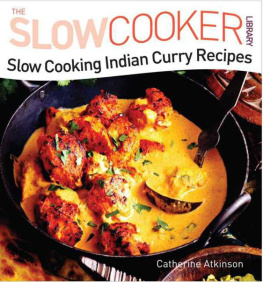Haroon Waseem - Essential Curry
Here you can read online Haroon Waseem - Essential Curry full text of the book (entire story) in english for free. Download pdf and epub, get meaning, cover and reviews about this ebook. year: 2018, genre: Children. Description of the work, (preface) as well as reviews are available. Best literature library LitArk.com created for fans of good reading and offers a wide selection of genres:
Romance novel
Science fiction
Adventure
Detective
Science
History
Home and family
Prose
Art
Politics
Computer
Non-fiction
Religion
Business
Children
Humor
Choose a favorite category and find really read worthwhile books. Enjoy immersion in the world of imagination, feel the emotions of the characters or learn something new for yourself, make an fascinating discovery.
- Book:Essential Curry
- Author:
- Genre:
- Year:2018
- Rating:4 / 5
- Favourites:Add to favourites
- Your mark:
- 80
- 1
- 2
- 3
- 4
- 5
Essential Curry: summary, description and annotation
We offer to read an annotation, description, summary or preface (depends on what the author of the book "Essential Curry" wrote himself). If you haven't found the necessary information about the book — write in the comments, we will try to find it.
Essential Curry — read online for free the complete book (whole text) full work
Below is the text of the book, divided by pages. System saving the place of the last page read, allows you to conveniently read the book "Essential Curry" online for free, without having to search again every time where you left off. Put a bookmark, and you can go to the page where you finished reading at any time.
Font size:
Interval:
Bookmark:
Essential Curry

2018 Haroon Waseem
All rights reserved.
Table of Contents
Contents
A curry is defined as a food, dish, or sauce in Indian cuisine seasoned with a mixture of pungent spices by Merriam-Webster. Does that sound vague and complex? Is it the dish or the sauce? Is it only in Indian cuisine? What about Thai curry or Japanese curry?
This definition is one of the reasons why many people are afraid of cooking curry. It seems like a daunting task. Looking at the long list of spices and smelling pungent odors doesnt help either. Think of your favorite curry, whether Indian, or Thai, or Japanese, or any other. Compare it to the ones that you will definitely not try again. There are certain elements that you will be able to pick out that put one over the other.
To me, a great curry is an experience of all five senses. Making curry requires creativity, improvisation, insight, and fun. This is not a book that will detail recipes for 100 different kinds of curries. This is a book that will hopefully allow you to make as many curries as your heart desires. I urge you to implement the concepts in this book after reading it. First, you will notice the curries you used to make will be elevated. Secondly, you will want to make curries that you didnt know were possible before. I hope that this book inspires you to create new curries.
This book will break down four essential elements of curry that make an extraordinary experience. Incorporating these elements will lead you to whip up delicious curries in no time. These 4 elements are:
- Aroma
- Complexity
- Body
- Textures
A curry should entice the appetite and, tease the palette, and flirt with the tongue long before it is plated. The irresistible aroma is one of the key elements of a great curry. It is achieved by sauting the aromatics and tempering the spices. Aromatics are essential to cooking in many cuisines. Aromatics vary by region and season. Tempering spices wakes up their flavors and/or infuse them in oil. This chapter will discuss how they play a part in making curry.

Onions, Garlic, and thyme are used as aromatics in many different cuisines
Aromatics
Aromatics are a combination of vegetables that are sauted or sweated in the beginning as a flavor base. The Cajun trinity, the French mirepoix, and the Italian soffritto are all examples of creating the aromatic base for those cuisines. Typically, the Indian curry version uses onion, garlic, and ginger as the aromatic base. Other ingredients such as chilis, tomatoes, cumin, turmeric, and various other ingredients can be added to supplement this aromatic combination per ones taste.
For a beginner, spending time understanding this process is crucial to yield great curries. The vegetables should be sauted on medium heat. The sliced or diced onions should be sauted first until they turn slightly golden. Finely minced or pureed garlic and ginger should be incorporated next and cooked with the onions, until the desired level of depth and caramelization is achieved.
Many curries are ruined by caramelizing the onions too much, and also by trying to hasten the process and not waiting for caramelization to take place before stopping the process. It is important to take the time to properly sweat these vegetables, before continuing.

A garnish of tempered spices decorates this bowl of lentils and adds aroma and flavor
Spice tempering
Spice tempering is frying whole or ground spices in oil before adding them to a dish. Unlike the aromatics which form the base of the dish, tempered spices are used in different steps to achieve different results.
First, whole spices (such as cumin, chilis, curry leaves etc.) are added to the oil to supplement the aromatics as mentioned earlier. Ground spices (such as curry powder, garam masala, cumin, coriander seed etc.) are also added at the very end of sauting the aromatics to yield a curry where flavors penetrate the core and the aroma penetrates the neighbors homes.
Moreover, tempered spices are also used at the very end of the cooking process. A tarka is an explosion of flavor that is added at the end of the dish. A tarka is made up of a small amount of whole spices (like cumin, chilis, ginger, or chilis etc.) fried in a dash of very hot oil, before being add as a garnish to the dish. Unlike the low and slow frying process before, this is a high and quick method in which spices are allowed to sizzle and splatter.
The sound and aroma of tarka fills the home with liveliness and the diners with anticipation. After the curry is cooked, plated, and served; there is nothing more irresistible than a garnish of sizzling cumin and chilis spooned on top of the curry in front of the hungry diner. With this incorporation of sound, curry truly becomes an experience of all five sense.
A curry is not curry unless it is complex in taste. It can be simple to make, but its differentiating feature lies in the complexity of flavor. It may seem like a grand undertaking to achieve those complex flavors, but my book aim to simplify that process, and make it second nature to curry lovers everywhere. A curry should incorporate six key elements of flavor: sweet, sour, salt, bitter, astringent, and pungent. We see different ingredients and variations of these six elements in different curries from all across the globe.
Notice that spice is not one of those key elements. In fact, there are many curries that are not spicy, yet they are still rich and complex in flavor. Unlike popular belief, one can enjoy making and eating great curries even if they cannot tolerate spicy food.
Lets move forward on how these six elements of flavor are incorporated in a curry.

Thai curries use coconut milk as a base that brings sweetness to the curry
Sweetness
Sweetness is primarily incorporated using onions. The aromatic base of the curry we discussed in the previous chapter gives incredible sweetness to the curry. To me, onions are the candy of vegetables. Caramelizing them produces incredible sweetness that is hard to resist. We see coconut milk used in Thai curries and carrots in Japanese curries to impart sweetness as well. Simple sweet ingredients like sugar and honey are also used. But they must be added carefully as they can over power the flavor very easily.
Sourness
Sourness in a curry is commonly achieved by using tomatoes or yogurt. Crushed or diced, whole or pasted; tomatoes are added to the aromatics to stop their sauting process and keep them from burning. After the integration of tomatoes, the frying process stops and a slow simmer is reached. Tomato juices are released and they mix with the aromatics and spices to form a thick and delicious body ready for meats or vegetables. Other ingredients like tamarind paste, sour plums, and even vinegar is utilized in different variations to achieve the same effect and complexity.
Saltiness
Saltiness is easiest to achieve by using salt to taste. However, one shouldnt be afraid to use soy sauce, tamari, fish sauce, anchovies, or other umami packed ingredients either. Regional differences determine how saltiness is incorporated into curries. Salt brings out the full flavors of a dish. It showcases each ingredient with its own flavor. Adding salt to an orange will make it taste more like an orange. When starting off, one should use salt by adding it and tasting the dish, then adding more as necessary. Make sure to let the salt dissolve completely into the dish before tasting so as not to risk adding too much.
Font size:
Interval:
Bookmark:
Similar books «Essential Curry»
Look at similar books to Essential Curry. We have selected literature similar in name and meaning in the hope of providing readers with more options to find new, interesting, not yet read works.
Discussion, reviews of the book Essential Curry and just readers' own opinions. Leave your comments, write what you think about the work, its meaning or the main characters. Specify what exactly you liked and what you didn't like, and why you think so.

